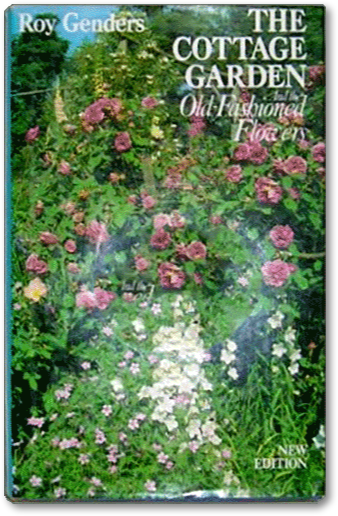
Musings » The Cottage Garden and the old-fashioned flowers


London
Pelham Books 1969 (re-issued 1987)
This delightful book appeared in my librarian’s corner unannounced. I still do not know who gave it to us. Quite possibly it was not intended to be a gift to the library but I pounced on it, put a garden club library label in it and classed it as our own. There is something called “eminent domain” and I think I just exercised it.
Why should such a modest and unassuming book cause me to behave in this uncharacteristically aggressive manner? Roy Genders was an English expert on horticulture who wrote dozens of books about the individual varieties of flowers as well as books about whole classes of plants. Scented Flowers of the World stands out as a striking example.
When it came to the cottage garden he approached the topic with exemplary historical skill. There are many books which purport to describe the classic English cottage garden but which are only vehicles for handsome photographs of landscape designers’ misguided efforts.
One of the basic tenets of a cottage garden is its lack of artificiality, its not having been designed in advance. The average workingman or labourer in early England had no rights to any land and had to make do with a minute scrap of ground next to his cottage. The most important need was for vegetables to extend the family’s meagre supplies of food.
Flowers were not the first thing that came to their minds. Gradually they brought wild plants from the edge of the forest. For years, only local, native plants were grown. These did well because perforce the cottagers provided the same conditions as the original habitat.
With improving prosperity the people began to obtain the new, exotic plants which entered England over a couple of centuries. We are talking hollyhocks, delphiniums, antirrhinums, carnations, and violas, all very early immigrants. Later there would be “geraniums” (pelargoniums), lilies, bugloss, sweet peas and various sorts of roses.
There was still no idea of a design. Everything was stuffed in close together. Workers were seriously exploited in those days and had almost no time or energy for gardening after working a long day. Once in a while, they would give the plants some manure and rake away the worst of the dead leaves and detritus. Otherwise, the plants were on their own.
This benign neglect resulted in many types of flower surviving undisturbed in old cottage gardens long after they were thought to have disappeared. It is striking that the majority of flowers we associate with cottage gardens nowadays are in fact of foreign origin (“exotic”).
Fierce floristic competition ruled among certain classes of artisan in the nineteenth century. These tradesmen worked at home in their cottages and devoted themselves to one or two kinds of flower. Because land was so scarce, most of the flowers were grown in pots.
The lace weavers of Paisley bred carnations selectively. The cotton workers in Lancashire doted on primulas, and in Scotland, polyanthus was supreme. They competed for prizes at annual fairs. Collectively, these workers were known as “florists”.
It all comes alive in Roy Genders’ book. If anyone has any other books by this author and wishes to donate them to the library, I am ready with my hand out.

